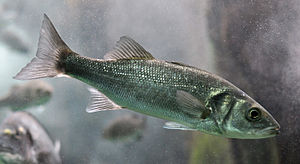European sea bass
| European sea bass | ||||||||||||
|---|---|---|---|---|---|---|---|---|---|---|---|---|

European sea bass ( Dicentrarchus labrax ) |
||||||||||||
| Systematics | ||||||||||||
|
||||||||||||
| Scientific name | ||||||||||||
| Dicentrarchus labrax | ||||||||||||
| ( Linnaeus , 1758) | ||||||||||||
The European sea bass or sea bass ( Dicentrarchus labrax ) is a fish from the family of sea bass (Moronidae).
features
The fish reach a maximum body length of about one meter and a weight of about 12 kilograms. They have an elongated body. The back is dark gray, the color is increasingly lighter on the sides, the belly is almost white. The dark side line is clearly visible. The generic name means "two-pronged perch".
Occurrence
The animals are found in the Eastern Atlantic from Morocco to Norway . But they also live in the Mediterranean and the Black Sea . They are most commonly found in the waters around the British Isles , especially in the North Sea . They live in a water depth of 10 to 100 meters, but swim and hunt down to knee-deep water. They are sometimes found in the brackish water of estuaries during the summer months . In the cold seasons, they swim off the coast in deep water.
Way of life
They are predatory and hunt various molluscs , crustaceans and fish at night . Mating takes place from January to March. The larvae hatch from the eggs laid by the females after about three days. Young animals live in flocks , but with increasing age they lose their sociability.
Exposure to climate change
The future survival of the European sea bass is impaired in the context of the climate crisis due to the associated increased CO 2 level in seawater, as this causes a changed reaction to sensory signals; Studies show that when European sea bass are exposed to increased CO 2 values (approx. 1,000 µatm), they have to be up to 42% closer to a source of odor than current CO 2 values (approx. 400 µatm) in order to to be able to track them down with their olfactory system , which reduces the likelihood of finding food or predators and thus their ability to survive.
Economical meaning
In ancient Rome, the European sea bass was a popular food fish . In the first half of the 1st century BC It was released into freshwater lakes and rivers with little success. From the middle of the 1st century BC BC it was one of the most common fish in the brackish water basins near the coast. Even today, the European sea bass is being reared in aquaculture . The fish is also known as Branzino ( Italian ), Brancin ( Croatian ), Robalo ( Portuguese ), Lubina ( Spanish ) and in French as Bar commun or Loup . In the kitchen language it is also called Loup de mer in the German-speaking area , but in French it denotes the spotted sea wolf and the striped sea wolf or the family of sea wolves .
Web links
- European seabass on Fishbase.org (English)
- Dicentrarchus labrax inthe IUCN 2013 Red List of Threatened Species . Posted by: Freyhof, J. & Kottelat, M., 2008. Retrieved February 10, 2014.
Individual evidence
- ↑ Porteus, CS, Hubbard, PC, Webster, TMU, van Aerle, R., Canário, AV, Santos, EM, & Wilson, RW (2018). Near-future CO 2 levels impair the olfactory system of a marine fish. Nature Climate Change, 8 (8), 737. https://doi.org/10.1038/s41558-018-0224-8
- ↑ Elena Nikulina and Ulrich Schmölcke: Fish farming in ancient Rome and their change in reputation in the light of the political situation . In: Writings of the natural science association for Schleswig-Holstein . tape 70 , 2008, p. 36–55 ( uni-kiel.de [PDF; 1000 kB ; accessed on May 17, 2015]).

